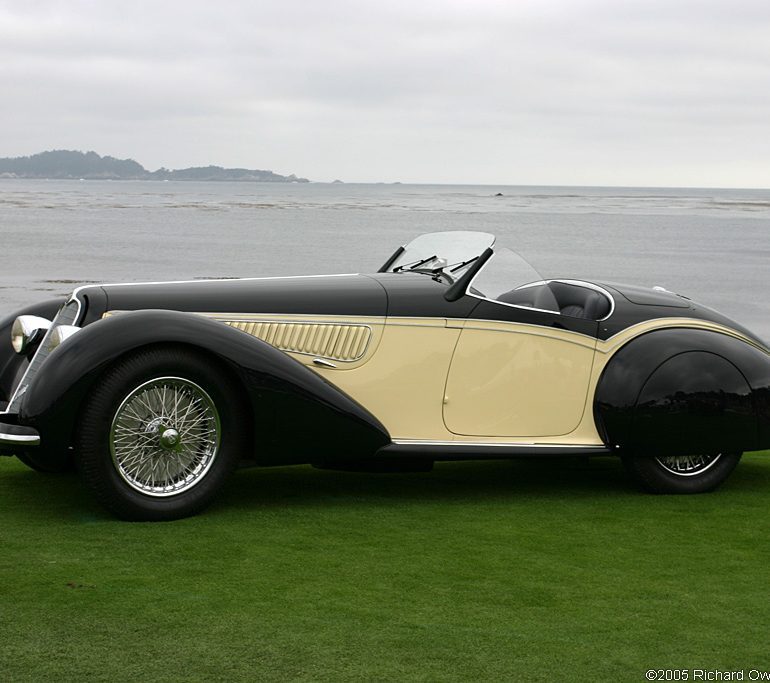1937→1938 Alfa Romeo 8C 2900B Corto Spyder
The first 2900s bodied by Carrozzeria Touring were dramatic spyders built on the shorter Corto 2900 chassis. These were loosely based off the 2900A Spyders which were bodied in-house by Alfa Romeo.
On the track, the 2900 competition cars benefited from a decade of Alfa Romeo progress and became the most successful of their time. A trio of 2900As placed first-second-third at the 1936 Mille Miglia, while three specially built 2900MMs accomplished the same feat at the 1938 edition. The decision to make a road-going variant of these winning designs must have been easy.
The chassis was outfitted very similar to the competition cars with twin trailing arms up front and a swing-arm suspension in the rear with both friction and hydraulic dampers.
The engine was similar to the Tipo B unit but was made from new castings in aluminum instead of magnesium. They retained a 10-main bearing crankshafts that sat in white metal babbits. The cylinder head was cast integral to the block with hemispherical combustion chambers and domed pistons. The valvetrain and axillary devices were all gear driven.
The first Corto Spyder appeared at the 1937 London Motor Show and Simon Moore reports the chassis being 412011. It was unique with a smaller rear overhang. After being shown at the Berlin motor show, the car was retained in Germany and modified by Karosserie Nowak to appear more like Horch. Five more short-wheel base Spyders were produced after 412011 by Touring and Pinin Farina made a sole cabriolet.
In December of 1942, Autocar tested a Touring-bodied 2900 which reached 60 mph in 9.4 seconds and they reported a price of £1,950.
L’Auto Italia described the car as “the fastest production car in the world” when featuring chassis 412019 shortly before its delivery to the Maharajah of Indore.
1937 Alfa Romeo 8C 2900B Corto Spyder Gallery
See full 1937 Alfa Romeo 8C 2900B Corto Spyder Gallery here.
In Detail
| submitted by | Richard Owen |
| type | Series Production Car |
| production years | 1937 – 1938 |
| released at | 1937 London Motor Show |
| production | 6 |
| price $ | $ 9,457 |
| price £/td> | £1,950 |
| engine | All Alloy Inline-8 |
| position | Front Longitudinal |
| aspiration | Twin Roots Superchargers |
| ignition | Vertex Magneto |
| valvetrain | Gear-Driven DOHC, 2 Valves / Cyl- |
| fuel feed | Twin Carburettors |
| displacement | 2905 cc / 177.3 in³ |
| bore | 68 mm / 2.68 in |
| stroke | 100 mm / 3.94 in |
| compression | 5.75:1 |
| power | 134.2 kw / 180.0 bhp @ 5200 rpm |
| specific output | 61.96 bhp per litre |
| bhp/weight | 140.85 bhp per tonne |
| redline | 5000 |
| body / frame | Aluminum Superleggera Body on Steel Ladder Frame |
| driven wheels | RWD |
| front tires | 5.5×19 |
| rear tires | 5.5×19 |
| front brakes | Hydrualic Drums |
| rear brakes | Hydrualic Drums |
| front wheels | F 48.3 x 11.4 cm / 19 x 4.5 in |
| rear wheels | R 48.3 x 11.4 cm / 19 x 4.5 in |
| steering | Worm & Sector |
| f suspension | Double Trailing Arms w/Coil Springs over Hydraulic Dampers |
| r suspension | Swing axles w/Radius Arms, Transverse Elliptic Leaf Spring, Hydraulic & Friction Dampers |
| curb weight | 1278 kg / 2818 lbs |
| transmission | 4-Speed Manual |
| tran clutch | Single Plate |
| gear ratios | 2.44:1, 1.50:1, 1.14:1, 0.88:1 |
| final drive | 4.54:1 |
| top speed | ~185.03 kph / 115 mph |
| 0 – 60 mph | ~9.4 seconds |
| fuel econ epa | 21.38 L/100 km or 11 mpg-us |
| fuel capacity | 83.27 litres or 22 gal. |




